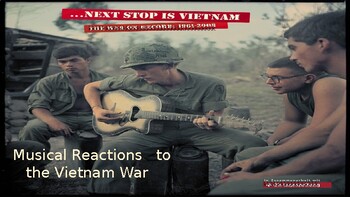Vietnam War: Musical Reactions of the 60s and 70s
- PPTX
Also included in
- Provided in this bundle...1. Graphic Organizers2. Nonfiction articles3. Mock Draft activity4. Constructed Response - prompt, rubric, pre-write5. Musical Resistance to the war in Vietnam6. Protest Song Project, Example, Worksheet7. Socratic Seminar - note sheets and rubric8. Research 9. Unit slideshoPrice $62.89Original Price $89.85Save $26.96
- How does ZERO planning sound? Lessons and resources for an entire year of 8th grade English placed in your hands? Included in this bundle is ABSOLUTELY EVERYTHING that you'll need to make it from August to June! The resources provided can be used in any order that you prefer - follow the pacing guidPrice $525.54Original Price $750.77Save $225.23
- The materials in this bundle could easily be Units for a new HISTORY centered elective at your school. This program relies heavily on the music of the time period to take students on an eccentric tour through World History. I strongly believe that MUSIC is the most powerful tool that we have to engaPrice $124.75Original Price $178.21Save $53.46
- In this Unit, students examine how Crosby, Stills, Nash, and Young’s “Ohio,” Merle Haggard’s “Okie From Muskogee” and Edwin Starr’s “War” articulated the divisive feelings Americans had about the war in the late 1960s and early 1970s. To supplement these songs, students will also watch clips from CNPrice $8.04Original Price $11.48Save $3.44
Description
In this Unit, students examine how Crosby, Stills, Nash, and Young’s “Ohio,” Merle Haggard’s “Okie From Muskogee” and Edwin Starr’s “War” articulated the divisive feelings Americans had about the war in the late 1960s and early 1970s. To supplement these songs, students will also watch clips from CNN Soundtracks and analyze polling data, news articles, and photographs from the era. By the end of the unit, students will know seminal events during the Vietnam War, including the Gulf of Tonkin Resolution, The Tet Offensive, the My Lai Massacre, the election of Richard Nixon, and the Kent State shootings. They will discuss the feelings Americans had about the Vietnam War, including the division between the “Doves” and “Hawks”, and heavily focus on the way popular music either directly contributed to discussions about the Vietnam War, or was appropriated by pro- and anti-Vietnam War groups. This unit can be done on its own or as part of a larger Vietnam War Unit (available as a bundle).
The Essential Question for students is: How were American’s divisive opinions over the Vietnam War articulated by musicians in the 1960s and early 1970s? The first activity has students reading about the 4 students killed at Kent State. After reading the article and watching a video clip (link embedded on the slide), students will write summaries - 5 Ws (objective) and opinions (subjective). A Gallery Walk to accompany this slideshow (available for FREE) asks students to look at images to compare a variety of things about the Hawks and Doves - style, protest posters, beliefs, and political cartoons. Analysis questions are included to help students fully analyze each image. The final slide provides two Extension Activities - one choice links students to the full CNN episode on the Kent State shootings, and the second requires research of social psychology terminology that can be applied to the war in Vietnam and how American's reacted during that time.









